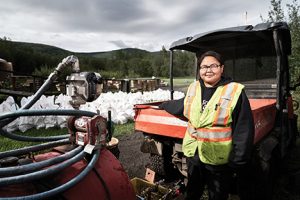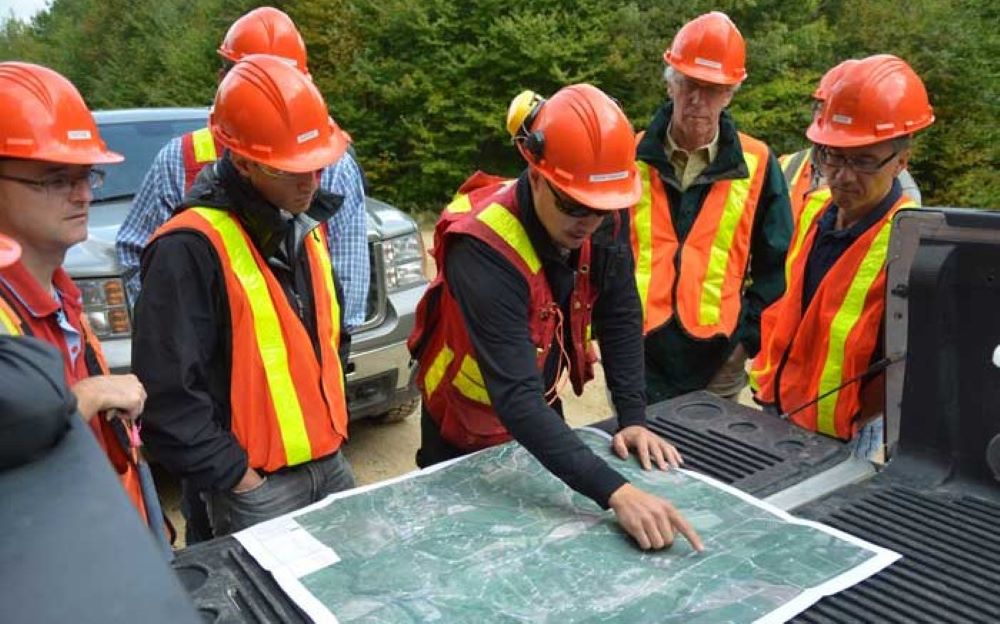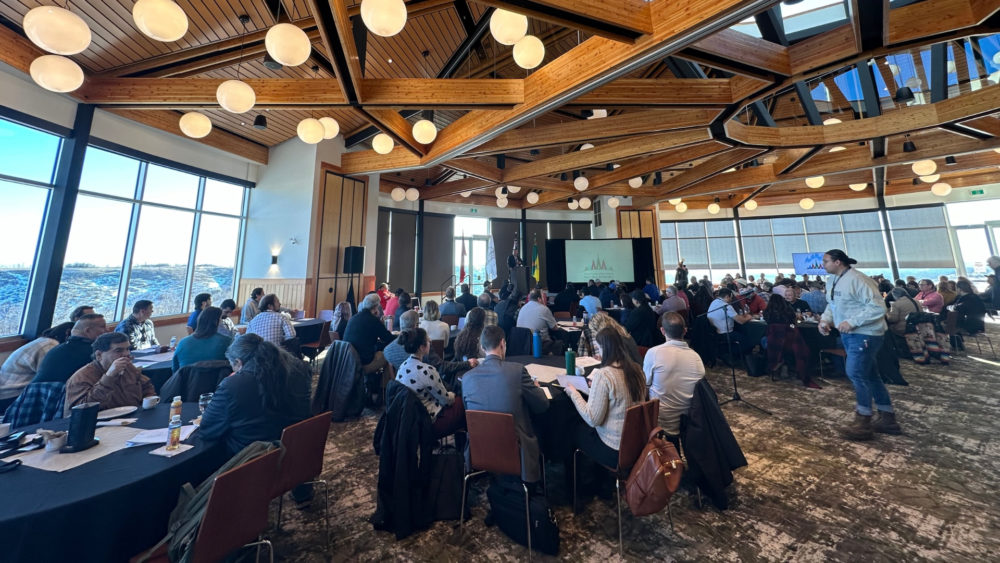New mines coming to Yukon, NWT and BC

Construction at the Eagle headframe in the Yukon. CREDIT: VICTORIA GOLD
Finding new mine developments in the Yukon, Northwest Territories and British Columbia is easy enough to do. What requires more effort is remembering that the projects outlined below have been many years in the making. They represent the tip of the iceberg – there are many others in various stages of exploration.
In the meantime here are six projects being taken to production in the near future.
Victoria Gold, Eagle (Dublin Gulch)

Aerial view of the Eagle gold project: CREDIT: VICTORIA GOLD
Construction is underway at Victoria’s Gold’s Eagle open pit gold project in the Yukon, and the project is expected to pour first gold in the second half of 2019.
The Eagle project has been shovel ready for some time, but it wasn’t until March 2018 that the junior announced a financing deal to build it. Victoria has arranged the funding from several partners – Orion Mine Finance (in the form of debt facilities), Osisko Gold Royalties (a streaming agreement) and Cat Financial (an equipment leasing facility). The cost to build a three-stage crushing plant, in-valley heap leach and carbon-in-leach recovery plant has been pegged at $500 million.
Victoria expects the mine to produce 200,000 oz. of gold annually with a mining rate of 33,700 t/d. The all-in sustaining cost is US$638 per oz., making the Eagle project a low cost producer over a projected 11-year life. The feasibility study used a gold price of US$1,250 per oz. That gives the project an after-tax net present value of $508 million (with a 5% discount rate) and an internal rate of return of 29.5%. The payback period after tax is 2.8 years.
The Eagle and the nearby Olive deposits have proven and probable reserves of 2.7 million oz. of gold contained in 123 million tonnes grading 0.67 g/t gold. Measured and indicated resources inclusive of reserves total 4 million oz. gold contained in 191 million tonnes averaging 0.65 g/t gold. A further inferred resource of 500,000 oz. gold is hosted in 24 million tonnes of material grading 0.61 g/t gold.
The Eagle deposit has several ore types – oxide granodiorite, altered granodiorite, unaltered granodiorite, oxide metasediments, and unaltered metasediments. The largest ore sources are the oxide granodiorite (29%) and the unaltered granodiorite (42%). Taken together over the life of the mine, gold recovery will be 55%.
The Olive deposit will contribute ore from oxide, mixed and sulphide type ores.
Goldcorp, Coffee

Goldcorp employee Chelsea Johnny at
the Coffee gold project in the Yukon.
CREDIT: GOLDCORP
Successful junior Kaminak Gold did the early work on the Coffee gold project, finding and outlining a substantial gold reserve and completing a feasibility study.
The study, released in early 2016, pegged preproduction capital costs at $291 million, sustaining costs and closure at $445 million, and included a $33 million (11%) contingency. That put the total capex at $1.6 billion – a not inconsiderable amount for a mine with a 10-year life that is expected to produce an average of 202,000 oz. of gold annually.
Coffee could pay back its development costs after taxes in only 2 years. The study put the after-tax NPV (at a 5% discount rate) at $445 million and the IRR at 37%.
The feasibility study attracted the attention of several larger miners. But it was Goldcorp who acquired Kaminak for $520 million in July 2016.
Goldcorp got right to work and at the end of June 2018 released reserve figures. The company outlined proven and probable reserves of 46.4 million tonnes averaging 1.45 g/t gold and containing 2.2 million oz. An additional measured and indicated resource of 20 million tonnes at 1.21 g/t gold contains 780,000 oz. Total contained gold (including inferred resources) comes to just over 4 million oz.
Coffee is imagined as a high grade, open pit, heap leach development and Goldcorp expects to begin production in 2021, in time to form a key part of its plan to increase total production by 20% by 2021. The property contains structurally hosted hydrothermal gold mineralization. There is significant exploration potential both along strike and at depth. With luck, Goldcorp, would like to grow it into a large district scale operation.
Goldcorp is advancing the project on all fronts. In April, a collaboration agreement was signed with Tr’ondëk Hwëch’in. The Yukon Environmental and Socio-Economic Board deemed the Coffee project adequate in August 2018, and public consultation was completed in November.
Meanwhile, permitting and engineering continues. There is a road as well as the mine to be permitted, and that work has just begun. Construction is expected to start in 2020.
Centerra Gold, Kemess Underground

Centerra Gold’s Kemess site, in B.C. CREDIT: CENTERRA GOLD
Centerra Gold became the 100% owner of the Kemess project in B.C. with its acquisition of AuRico Metals in January 2018. The deal included the former open pit mine and a 25,000 t/d conventional mill, road, power, tailings facility, rail load-out, camp and airstrip together valued at about $1 billion.
AuRico produced a feasibility study in 2016 for an underground mine 6 km away from the processing plant, and this undoubtedly played a large part in Centerra’s offer. The study examined the development of a low cost panel caving mine. The feasibility looked at a base case and a consensus case that had slightly higher copper and silver prices.
Kemess Underground has a base case, after-tax NPV (at a 5% discount rate) of $289 million, or a consensus NPV of $421 million. The after-tax IRR would be 12.6% for the base case and 15.4% for the consensus case. The net cash flow after taxes was estimated at $746 million (base) or $969 million (consensus).
The study projected a life-of-mine annual production rate of 106,000 oz. of gold and 27 million lb. of copper. All-in sustaining costs would be US$718 per oz. for gold and US$1.44 per lb. copper, on a co-product basis. Taken on a by-product basis, the cost of producing an ounce of gold would be only US$244 per oz. over the life of mine.
Normal course permitting is soon to be complete, and development of the decline is slated to begin next year. First production is targeted for 2022. Pre-commercial capex is pegged at $450 million plus an additional $153 million in capitalized operating costs net of revenue.
The project hosts proven and probable reserves of 107.4 million tonnes at 0.54 g/t gold, 0.27% copper and 1.99 g/t silver. Total measured and indicated resources are 246.4 million tonnes grading 0.42 g/t gold, 0.22% copper and 1.75 g/t silver for 3.3 million oz. of gold, 1.2 billion lb. of copper, and 13.9 million oz. of silver.
Developing Kemess Underground will keep Centerra busy for the next three years. But the company is looking ahead to the Kemess East property. The preliminary economic assessment for that suggests total measured and indicated resources of 113.1 million tonnes averaging 0.46 g/t gold, 0.38% copper and 1.94 g/t silver, containing 1.7 million oz. of gold, 954 million lb. of copper, and 7.1 million oz. of silver.
NorZinc, Prairie Creek

NorZinc’s Prairie Creek zinc-lead-silver project in the Northwest Territories. CREDIT: NORZINC
The Prairie Creek zinc-lead-silver project in the Northwest Territories may set a record for the longest mine development undertaking. Mineralization was discovered in 1924, and the first underground work was carried out in 1970. Hoping to corner the silver market, the Hunt brothers bought the property in 1980. Work continued until more than 90% of the surface facilities was complete for a 1000-t/d mine. The demise of the Hunt’s Procan Exploration Co. and subsequent bankruptcy of then-owner Cadillac Explorations left the project tied up in litigation until 1990.
Since acquiring the project in the early 1990s, NorZinc and its predecessor Canadian Zinc, have made advances on several fronts from where the Hunt brothers left the project. On the technical side, they have completed more than 78,000 metres of exploration drilling in almost 300 holes, and expanded the resources. NorZinc also converted resources to reserves and completed the 2017 feasibility study and has made progress in building relationships with the various Indigenous groups in the region.
Most importantly the focus of the project has become zinclead- silver rather than rely primarily on the silver content.
All of which is to say it has been 59 years since development work began, and close to 100 years since discovery. Even for modern mining projects this is an exceptionally long time.
NorZinc has been granted all the major operational permits – water licence, mine land use permit, and the Liard transfer facility permit. The company expects to receive an all season BC & THE NORTHWEST road permit by mid-2019. The target date for mine start-up is August 2022.
In 2015 a mineral resource estimate was made for the Main quartz vein where most of the mining will take place. Measured an indicated resources were 5.5 million tonnes grading 178 g/t silver, 10.2% zinc and 11.6% lead. There are also inferred resources of 5.3 million tonnes at 199 g/t silver, 12.9% zinc and 8.7% lead.
Two other zones – the Stockwork and Stratabound – also have resources, but won’t be mined until much later in the mine life.
For the 2017 feasibility study, proven and probable reserves were calculated for the three zones. The Main quartz vein will provide most of the ore mined from 5.7 million tonnes grading 149.21 g/t silver, 8.74% zinc and 9.67% lead. Based on the reserves alone, the mine has a 15-year mine life.
A 1,200-t/d concentrator is planned with a new dense media separation plant between the crushers and grinding. Ore slurry will then undergo three stages of flotation. The mill will produce separate zinc and lead concentrates both containing significant silver – 135 to 150 g/t and 700 to 800 g/t silver, respectively. Final tailings will be thickened in a new paste fill plant and used as backfill.
NorZinc anticipates pre-production capital cost will be $279 million including a contingency of $26 million.
Fortune Minerals, Nico

Test mining at Fortune Minerals’ Nico cobalt-gold-bismuth copper project in the
Northwest Territories. CREDIT: FORTUNE MINERALS
Fortune Minerals discovered the Nico deposit, which now has resources of cobalt, gold, bismuth and copper, in 1996. The company now plans to build a mine and concentrator in the Northwest Territories, 160 km northwest of Yellowknife, and a metals processing plant in Saskatchewan.
The project is in the permitting stage. Both the federal and Tlicho governments have approved the Nico mine and mill environmental assessment. Construction and operation will begin when the Type A water licence and land use permit are issued and financing has been secured.
Pre-production capital requirements in the Northwest Territories total $346.5 million, including $52.4 million for the open pit and $170 million for the mill and related infrastructure.
No estimate has yet been made as the development costs for the underground portion of the deposit, but sustaining capital for the mine is estimated at $38.9 million.
Fortune has also received environmental approval from the province for its Saskatchewan metallurgical processing plant (SMPP). The $242.5-million hydrometallurgical facility will be located near Saskatoon.
Proven and probable open pit reserves at Nico total 32.5 million at 0.96 g/t gold, 0.11% cobalt, 0.14% bismuth and 0.04% copper. Measured and indicated open pit resources total 30 million tonnes averaging 1.1 g/t gold, 0.15% bismuth and 0.12% copper.
The underground portion of the deposit contains proven and probable reserves of 577,000 tonnes grading 4.96 g/t gold, 0.1% cobalt, 0.17% bismuth, and 0.02% copper. Underground measured and indicated resources come to 995,000 tonnes grading 1.85% gold, 0.07% bismuth and 0.16% copper.
Wildsky Resources, Cassiar

Wildsky Resources’ Cassiar gold property in B.C. CREDIT: WILDSKY RESOURCES
Wildsky’s Cassiar gold property in B.C. covers the entire Cassiar gold camp that was discovered in 1874. It has been the site of intense exploration and mining of both historical open pit and underground gold mines – Main (formerly Erickson), Bain, Cusac, Taurus, Sable, Plaza and more along the Vollaug vein. These past producers are credited with 350,650 oz. of gold output.
Historic placer production (McDame, Snow, Troutline and Quartzrock Creeks) totalled about 74,500 oz., including a 40-oz. nugget.
The potential is there, and Wildsky is determined to restart production. If the Wildsky name is new to our readers, perhaps they may know the company better by its previous incarnations, China Minerals Mining or Hawthorne Gold.
The Table Mountain deposit yielded its first near surface gold veins in 1934-35. Ownership shifted and production was on-again, off-again until flooding put a stop to production in 2007. The property was placed on care and maintenance in 2011.
The history of the Taurus area is similar – discovery in 1934- 35, and a brief period of production totalling 35,000 oz. of gold.
Generally speaking, the Cassiar camp consists of orogenic (mesothermal) auriferous quartz veins. The veins are well defined and characterized by white to clear bull quartz and lesser iron-magnesium carbonate, calcite and traces of sericite.
All of which is to say that if you go hunting for gold, go where the gold is.
Although no resource estimate has been tabled yet, Wildsky has been drilling both the Table Mountain tailings area and the Lucky soil grid anomaly. The tailings samples were subjected to both wet and dry gravity separation with head grades calculated at 2.56 and 2.18 g/t gold, respectively.





Comments